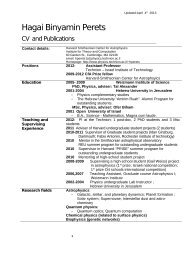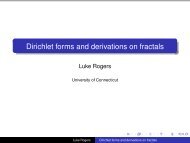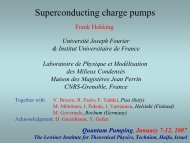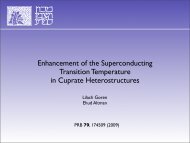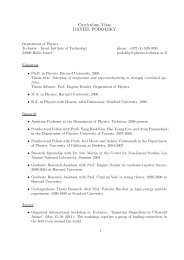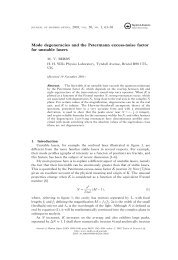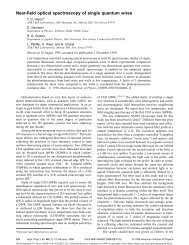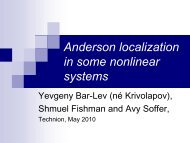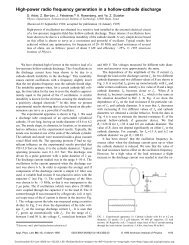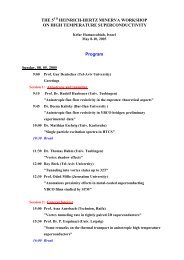Long range triplet SC in LCMO/YBCO bilayers - Physics@Technion
Long range triplet SC in LCMO/YBCO bilayers - Physics@Technion
Long range triplet SC in LCMO/YBCO bilayers - Physics@Technion
You also want an ePaper? Increase the reach of your titles
YUMPU automatically turns print PDFs into web optimized ePapers that Google loves.
PHYSICAL REVIEW B 83, 064510 (2011)<br />
<strong>Long</strong>-<strong>range</strong> proximity effect <strong>in</strong> La2/3Ca1/3MnO3/(100)YBa2Cu3O7−δ ferromagnet/superconductor<br />
<strong>bilayers</strong>: Evidence for <strong>in</strong>duced <strong>triplet</strong> superconductivity <strong>in</strong> the ferromagnet<br />
Yoav Kalcheim, 1 Tal Kirzhner, 2 Gad Koren, 2 and Oded Millo 1<br />
1 Racah Institute of Physics and the Hebrew University Center for Nanoscience and Nanotechnology,<br />
The Hebrew University of Jerusalem, Jerusalem 91904, Israel<br />
2 Department of Physics, Technion-Israel Institute of Technology, Haifa 32000, Israel<br />
(Received 12 September 2010; revised manuscript received 21 November 2010; published 17 February 2011)<br />
Scann<strong>in</strong>g tunnel<strong>in</strong>g spectroscopy measurements conducted on epitaxially grown <strong>bilayers</strong> of half-metallic<br />
ferromagnetic La2/3Ca1/3MnO3 (<strong>LCMO</strong>) on superconduct<strong>in</strong>g (100)YBa2Cu3O7−δ reveal long-<strong>range</strong> penetration<br />
of superconduct<strong>in</strong>g order <strong>in</strong>to the <strong>LCMO</strong>. This anomalous proximity effect manifests itself <strong>in</strong> the tunnel<strong>in</strong>g spectra<br />
measured on the <strong>LCMO</strong> layer as gaps and zero-bias conductance peaks. Remarkably, these proximity-<strong>in</strong>duced<br />
spectral features were observed for <strong>bilayers</strong> with <strong>LCMO</strong> thickness of up to 30 nm, an order of magnitude larger<br />
than the expected ferromagnetic coherence length <strong>in</strong> <strong>LCMO</strong>. We argue that this long-<strong>range</strong> proximity effect<br />
can be accounted for by the formation of sp<strong>in</strong>-<strong>triplet</strong> pair<strong>in</strong>g at the <strong>LCMO</strong> side of the bilayer due to magnetic<br />
<strong>in</strong>homogeneity at the <strong>in</strong>terface or at doma<strong>in</strong> walls. Possible symmetries of the <strong>in</strong>duced order parameter are<br />
discussed.<br />
DOI: 10.1103/PhysRevB.83.064510 PACS number(s): 74.45.+c, 74.55.+v, 74.20.Rp<br />
I. INTRODUCTION<br />
Significant research has been dedicated lately to the characterization<br />
of half-metallic ferromagnets (HMF) motivated<br />
by their application <strong>in</strong> sp<strong>in</strong>tronics as sources of sp<strong>in</strong>-polarized<br />
current. The proximity effect <strong>in</strong> HMF superconductor (<strong>SC</strong>)<br />
junctions has also drawn much attention recently due to its<br />
possible application <strong>in</strong> magnetization-controlled Josephson<br />
junctions1 and, more generally, as a means for <strong>in</strong>vestigat<strong>in</strong>g<br />
the <strong>in</strong>terplay between the compet<strong>in</strong>g orders of ferromagnetism<br />
(F) and <strong>SC</strong>. The underly<strong>in</strong>g mechanism of the proximity effect<br />
(PE) <strong>in</strong> a normal metal (N) <strong>in</strong> good electrical contact with<br />
a <strong>SC</strong> is the Andreev reflection (AR), whereby a holelike<br />
quasiparticle from the N side imp<strong>in</strong>g<strong>in</strong>g on the <strong>in</strong>terface is<br />
retro-reflected as an electronlike quasiparticle with opposite<br />
sp<strong>in</strong>, destroy<strong>in</strong>g a Cooper pair on the <strong>SC</strong> side. As a result,<br />
superconductivity is reduced <strong>in</strong> the <strong>SC</strong> side of the <strong>in</strong>terface,<br />
and pair<strong>in</strong>g correlations and thus a <strong>SC</strong> order parameter (OP) are<br />
<strong>in</strong>duced <strong>in</strong> N. At a f<strong>in</strong>ite temperature T , superconduct<strong>in</strong>g correlations<br />
will be observed <strong>in</strong> N up to a distance ξN = √ ¯hD/kBT<br />
from the N-<strong>SC</strong> <strong>in</strong>terface, where D is the diffusion coefficient.<br />
Beyond this so-called normal coherence length, typically of<br />
the order of tens of nanometers, the holelike and electronlike<br />
quasiparticles start los<strong>in</strong>g phase coherence. The AR process<br />
or the PE are naturally expected to be drastically suppressed<br />
at F-<strong>SC</strong> <strong>in</strong>terfaces due to the exchange <strong>in</strong>teraction <strong>in</strong> F.<br />
Indeed, by apply<strong>in</strong>g the methodology orig<strong>in</strong>ally <strong>in</strong>troduced by<br />
Fulde, Ferrel, Lark<strong>in</strong>, and Ovch<strong>in</strong>ikov2,3 (FFLO) for treat<strong>in</strong>g<br />
magnetic superconductors to the problem of F-<strong>SC</strong> junctions,<br />
it was shown4,5 that the exchange field Eex <strong>in</strong> F reduces the<br />
coherence length <strong>in</strong> the ferromagnet ξF to ¯hvF /2Eex <strong>in</strong> the<br />
clean limit (where vF is the Fermi velocity) and to √ ¯hD/2Eex<br />
<strong>in</strong> the dirty limit, both of which are typically of the order of<br />
1nm.<br />
However, recent studies on NbTiN-CrO2-NbTiN (<strong>SC</strong>-<br />
HMF-<strong>SC</strong>) (Ref. 1) and Nb-Cu2MnAl-Nb (<strong>SC</strong>-<strong>in</strong>termetallic<br />
F-<strong>SC</strong>) (Ref. 6) Josephson junctions revealed a long-<strong>range</strong><br />
PE where the supercurrent between the two <strong>SC</strong> electrodes<br />
was measured even when the F-layer thickness was much<br />
larger than ξF . Keizer et al. 1 attributed their f<strong>in</strong>d<strong>in</strong>gs to the<br />
formation of a <strong>triplet</strong>-pair<strong>in</strong>g component at the CrO2-NbTiN<br />
<strong>in</strong>terfaces, as predicted by Bergeret, Volkov, and Efetov7 and<br />
by Eschrig et al. 8 The long-<strong>range</strong> Josephson effect reported by<br />
Sprungmann6 was similarly attributed by L<strong>in</strong>der and Sudbo9 to <strong>triplet</strong> pair<strong>in</strong>g, formed due to sp<strong>in</strong>-active zones <strong>in</strong> the<br />
Nb-Cu2MnAl <strong>in</strong>terfaces. A <strong>triplet</strong> component with parallel<br />
sp<strong>in</strong>s can support AR <strong>in</strong> a similar manner as <strong>in</strong> s<strong>in</strong>glet<br />
pair<strong>in</strong>g <strong>in</strong> N-<strong>SC</strong> junctions, giv<strong>in</strong>g rise to a PE on a length<br />
scale comparable to ξN. The orbital symmetry of the <strong>in</strong>duced<br />
<strong>triplet</strong>-pair<strong>in</strong>g correlations may be either even (s wave, d wave)<br />
or odd (p wave, f wave), correspond<strong>in</strong>g, respectively, to an<br />
odd or even dependence on the Matsubara frequency. 10,11<br />
<strong>Long</strong>-<strong>range</strong> Josephson coupl<strong>in</strong>g was found also for junctions<br />
consisit<strong>in</strong>g of the high-temperature superconductor<br />
YBa2Cu3O7−δ (<strong>YBCO</strong>) and the it<strong>in</strong>erant ferromagnet SrRuO3<br />
(SRO). 12 Subsequently, STM measurements13 suggested that<br />
this long-<strong>range</strong> proximity effect (LRPE) may take place<br />
only locally along the doma<strong>in</strong> walls (DWs) of the SRO.<br />
The tunnel<strong>in</strong>g dI/dV versus V spectra revealed proximity<br />
superconduct<strong>in</strong>g gaps on the surface of SRO layers much<br />
thicker than the expected ξF , but these were conf<strong>in</strong>ed to<br />
strips of width consistent with the DW size of SRO. Thus,<br />
they attributed the local LRPE to the crossed Andreev<br />
reflections (CARE) process, 14,15 whereby a hole imp<strong>in</strong>g<strong>in</strong>g on<br />
the <strong>in</strong>terface <strong>in</strong> one magnetic doma<strong>in</strong> is retro-reflected as an<br />
electron with opposite sp<strong>in</strong> polarization <strong>in</strong> an adjacent doma<strong>in</strong><br />
hav<strong>in</strong>g opposite magnetization. It should be noted that this<br />
process can take place only if the DW width is up to a few<br />
times larger than the coherence length <strong>in</strong> the <strong>SC</strong> side of the<br />
junction ξS, 16 which is ∼2 nm <strong>in</strong> <strong>YBCO</strong>. Volkov and Efetov, 17<br />
on the other hand, attributed this LRPE to the formation of an<br />
odd-frequency <strong>triplet</strong> s-wave pair<strong>in</strong>g component <strong>in</strong> the DWs<br />
of F.<br />
In order to check whether the CARE process is <strong>in</strong>deed<br />
essential for LRPE, we studied <strong>in</strong> this work the <strong>bilayers</strong> of<br />
<strong>YBCO</strong> coated by the HMF La2/3Ca1/3MnO3 (<strong>LCMO</strong>). The<br />
DW width <strong>in</strong> th<strong>in</strong> <strong>LCMO</strong> films at 4.2 K is estimated18 to<br />
be ∼20 nm (although this value may depend on substrate,<br />
1098-0121/2011/83(6)/064510(6) 064510-1<br />
©2011 American Physical Society
YOAV KALCHEIM, TAL KIRZHNER, GAD KOREN, AND ODED MILLO PHYSICAL REVIEW B 83, 064510 (2011)<br />
preparation process, and film thickness), which is much<br />
larger than ξS <strong>in</strong> <strong>YBCO</strong>, and thus the CARE process should<br />
be largely suppressed. Surpris<strong>in</strong>gly, our tunnel<strong>in</strong>g spectra<br />
revealed spectroscopic features conform<strong>in</strong>g to proximity<strong>in</strong>duced<br />
superconductivity even on <strong>LCMO</strong> layers as thick<br />
as 30 nm, an order of magnitude larger than the FFLO<br />
predicted ξF . Moreover, these features were not conf<strong>in</strong>ed only<br />
to narrow strips (as <strong>in</strong> our previous study 13 of SRO/<strong>YBCO</strong><br />
<strong>bilayers</strong>) and both gaps and zero-bias conductance peaks<br />
(ZBCP) were measured. Our data thus suggest, after rul<strong>in</strong>g<br />
out the CARE mechanism, that proximity-<strong>in</strong>duced <strong>triplet</strong><br />
pair<strong>in</strong>g <strong>in</strong> the <strong>LCMO</strong> layer plays an important role <strong>in</strong> the<br />
PE observed <strong>in</strong> our samples. In a recent experiment, evidence<br />
for proximity-<strong>in</strong>duced <strong>triplet</strong> pair<strong>in</strong>g at the <strong>SC</strong> side of F/<strong>SC</strong><br />
(In/Co or In/Ni) junctions was provided. 19 In this work, on<br />
the other hand, the proximity-<strong>in</strong>duced <strong>triplet</strong> correlations are<br />
found on the F side.<br />
II. EXPERIMENT<br />
We have studied epitaxial <strong>bilayers</strong> consist<strong>in</strong>g of <strong>LCMO</strong><br />
films deposited on optimally doped a-axis (100)<strong>YBCO</strong> films<br />
grown by laser ablation deposition on (100)SrTiO3 (STO)<br />
substrates. The <strong>YBCO</strong> was deposited on the STO wafer <strong>in</strong><br />
two steps. First, a 45-nm-thick template layer of <strong>YBCO</strong> was<br />
deposited at a wafer temperature of 600 ◦ C. Then, a second<br />
90-nm-thick <strong>YBCO</strong> layer was prepared at 750 ◦ C. The surface<br />
area of the <strong>YBCO</strong> consisted of 95% (100)<strong>YBCO</strong> (verified by<br />
x-ray diffraction) with no traces of (110) orientation found.<br />
The <strong>LCMO</strong> layers were grown on top of the <strong>YBCO</strong> at 790 ◦ C<br />
and annealed for one hour at 450 ◦ C <strong>in</strong> 0.5 Atm oxygen<br />
environment. The whole process was performed <strong>in</strong> situ without<br />
break<strong>in</strong>g the vacuum, and given the good lattice match<strong>in</strong>g<br />
between <strong>YBCO</strong> and <strong>LCMO</strong>, high <strong>in</strong>terface transparency could<br />
be obta<strong>in</strong>ed, which is important for the AR process to take<br />
place. The thickness of our <strong>LCMO</strong> layers <strong>range</strong>d between 15<br />
to 50 nm with surface roughness of ∼1 nmontopofthe<br />
<strong>YBCO</strong> crystallites. Full coverage of the <strong>YBCO</strong> by <strong>LCMO</strong><br />
was confirmed by x-ray photoelectron spectroscopy (XPS)<br />
and time-of-flight secondary ion mass spectrometry measurements.<br />
Magnetoresistance and resistance versus temperature<br />
measurements of the samples reveal a ferromagnetic transition<br />
of the <strong>LCMO</strong> layer at ∼250 K and the <strong>SC</strong> transition of <strong>YBCO</strong><br />
at ∼88 K, as presented <strong>in</strong> Fig. 1. It is important to note that<br />
a-axis <strong>YBCO</strong> films were chosen for this study, rather than<br />
the more common c-axis (001)<strong>YBCO</strong> films, s<strong>in</strong>ce the PE is<br />
significantly suppressed along the c axis. 20,21<br />
Samples were transferred <strong>in</strong> dry atmosphere to our cryogenic<br />
STM after be<strong>in</strong>g exposed to ambient air for less than 10<br />
m<strong>in</strong>utes. After evacuation, the STM chamber was filled with<br />
He exchange gas at 1 Torr and then cooled down to 4.2 K,<br />
where all the measurements presented here were performed<br />
us<strong>in</strong>g a Pt-Ir tip. Several control measurements were performed<br />
at temperatures up to 150 K to verify that the spectroscopic<br />
features associated with <strong>SC</strong> (gaps and ZBCPs) <strong>in</strong>deed vanish<br />
above the Tc of <strong>YBCO</strong>. Topographic images were taken <strong>in</strong> the<br />
standard constant current mode with bias voltages ∼100 mV,<br />
well above the <strong>SC</strong> gap. The tunnel<strong>in</strong>g dI/dV versus V spectra,<br />
which are proportional to the local density of states (DOS),<br />
064510-2<br />
MR (Ohm)<br />
R (Ohm)<br />
0.4<br />
0.0<br />
-0.4<br />
-0.8<br />
-1.2<br />
70<br />
60<br />
50<br />
40<br />
30<br />
20<br />
10<br />
0<br />
120 160 200 240 280<br />
T (K)<br />
0 50 100 150 200 250 300<br />
T (K)<br />
FIG. 1. (Color onl<strong>in</strong>e) (a) Magnetoresistance R(2T )-R(0) measurement<br />
of a 20-nm <strong>LCMO</strong>/(100)<strong>YBCO</strong> bilayer as a function<br />
of temperature show<strong>in</strong>g the ferromagnetic transition at ∼250 K.<br />
The <strong>in</strong>set shows the structure of our samples, the direction of the<br />
magnetic field applied <strong>in</strong> the magnetoresistance measurement, and the<br />
tunnel<strong>in</strong>g direction <strong>in</strong> the STM measurements (performed at H = 0).<br />
(b) Resistance vs temperature curve of the same <strong>LCMO</strong>/<strong>YBCO</strong><br />
bilayer depict<strong>in</strong>g a superconduct<strong>in</strong>g transition at ∼88 K. The <strong>LCMO</strong><br />
ferromagnetic transition is also manifested here <strong>in</strong> the slope change<br />
at ∼250 K.<br />
were numerically derived from the I-V curves acquired on<br />
the <strong>LCMO</strong> surface while momentarily disconnect<strong>in</strong>g the STM<br />
feedback loop.<br />
III. RESULTS<br />
Tunnel<strong>in</strong>g dI/dV versus V curves represent<strong>in</strong>g the most<br />
typical spectroscopic features found on our samples are<br />
portrayed <strong>in</strong> Fig. 2. Figures 2(a) and 2(b) do not show<br />
any <strong>SC</strong>-like features. Figure 2(a) exhibits a nearly constant<br />
metalliclike DOS, while Fig. 2(b) exhibits a wide <strong>in</strong>sulatorlike<br />
gap structure. These spectra are very similar to those reported<br />
<strong>in</strong> Ref. 22, correspond<strong>in</strong>g to conductive and <strong>in</strong>sulat<strong>in</strong>g regions,<br />
respectively, coexist<strong>in</strong>g <strong>in</strong> <strong>LCMO</strong> films. Regions exhibit<strong>in</strong>g<br />
such features were found on all our samples, with abundance<br />
that grew with <strong>in</strong>creas<strong>in</strong>g <strong>LCMO</strong> thickness. However, <strong>in</strong> many
LONG-RANGE PROXIMITY EFFECT IN La2/3Ca ... PHYSICAL REVIEW B 83, 064510 (2011)<br />
-30 -20 -10 0 10 20 30<br />
FIG. 2. (Color onl<strong>in</strong>e) Tunnel<strong>in</strong>g dI/dV vs V spectra acquired at<br />
4.2 K on <strong>LCMO</strong>/(100)<strong>YBCO</strong> <strong>bilayers</strong> show<strong>in</strong>g the five ma<strong>in</strong> different<br />
spectral features measured on these F/<strong>SC</strong> <strong>bilayers</strong> (shifted for clarity).<br />
Curves (a) and (b) show no signature of a PE, where presumably,<br />
curve (a) was acquired over a metallic <strong>LCMO</strong> region and curve<br />
(b) was taken on a more <strong>in</strong>sulat<strong>in</strong>g region. The upper three curves<br />
manifest proximity-<strong>in</strong>duced <strong>SC</strong> order <strong>in</strong> the <strong>LCMO</strong> layer. Curve (c)<br />
shows the most prom<strong>in</strong>ent such spectral feature that appeared <strong>in</strong><br />
our measurements, a <strong>SC</strong>-like gap <strong>in</strong> the DOS, whereas (d) and (e)<br />
portray ZBCPs, <strong>in</strong>dicative of a sign-chang<strong>in</strong>g (p-wave or d-wave)<br />
order parameter. The ZBCPs and gaps appeared even on <strong>LCMO</strong><br />
layers of 30 nm thickness [curve (d)], but not on 50 nm thickness<br />
and not above Tc, <strong>in</strong>dicat<strong>in</strong>g a long-<strong>range</strong> proximity effect that we<br />
attribute to <strong>in</strong>duced <strong>triplet</strong> pair<strong>in</strong>g.<br />
regions, smaller gaps, hav<strong>in</strong>g suppressed <strong>SC</strong> coherence peaks<br />
(the so-called gaplike features) at 8–10 mV were observed<br />
<strong>in</strong> Fig. 2(c), <strong>in</strong>dicative of PE due to the <strong>SC</strong> <strong>YBCO</strong> film.<br />
Interest<strong>in</strong>gly, ZBCPs also appeared with<strong>in</strong> such gapped areas,<br />
although less frequently. The ZBCP were found to be either<br />
embedded with<strong>in</strong> a gaplike feature [Fig. 2(e)]ornot[Fig.2(d)],<br />
and <strong>in</strong> some cases showed splitt<strong>in</strong>g (see the follow<strong>in</strong>g). We<br />
recall here <strong>in</strong> pass<strong>in</strong>g that the ZBCP is one of the hallmarks of<br />
anisotropic sign-chang<strong>in</strong>g order parameters, such as p wave<br />
or d wave, although a correspond<strong>in</strong>g small correction to<br />
the zero-energy DOS was predicted also for <strong>in</strong>duced s-wave<br />
pair<strong>in</strong>g <strong>in</strong> the ferromagnet. 17 The <strong>SC</strong>-like spectroscopic<br />
features were observed on large areas of the 15–20-nm-thick<br />
<strong>LCMO</strong> samples, but their abundance decreased with <strong>LCMO</strong><br />
thickness. No such features were detected for the 50-nmthickness<br />
<strong>LCMO</strong> bilayer, on which only the aforementioned<br />
metalliclike and <strong>in</strong>sulat<strong>in</strong>g-like spectra were measured. It is<br />
also important to note that <strong>SC</strong>-like features were not observed<br />
above the Tc of <strong>YBCO</strong> for all <strong>bilayers</strong>, <strong>in</strong>dicat<strong>in</strong>g that they are<br />
<strong>in</strong>deed associated with the PE.<br />
We shall now discuss the spatial distribution of regions<br />
where <strong>SC</strong>-like features appeared. On few occasions, the gaps<br />
were conf<strong>in</strong>ed to well-def<strong>in</strong>ed strips, ∼40 nm wide, bordered<br />
by regions exhibit<strong>in</strong>g metalliclike spectra (Ohmic I-V curves),<br />
as shown <strong>in</strong> Fig. 3. The resemblance of the l<strong>in</strong>e width to<br />
that of the DW <strong>in</strong> <strong>LCMO</strong> suggests that, <strong>in</strong> these cases, the<br />
spectra were acquired over a DW where the PE may be locally<br />
064510-3<br />
FIG. 3. (Color onl<strong>in</strong>e) STM measurement of the evolution of the<br />
local DOS (dI/dV vs V tunnel<strong>in</strong>g spectra) along two transverse l<strong>in</strong>es<br />
on a 15-nm <strong>LCMO</strong>/(100)<strong>YBCO</strong> bilayer. The gaps <strong>in</strong> the DOS along<br />
the green (vertical) and the blue (horizontal) l<strong>in</strong>es are shown <strong>in</strong> (b)<br />
and (c), respectively. These data suggest that the LRPE <strong>in</strong> this region<br />
may be mediated by a doma<strong>in</strong> wall. The width of the gapped region<br />
<strong>in</strong> (c), ∼40 nm, is of the order of the doma<strong>in</strong>-wall width <strong>in</strong> <strong>LCMO</strong>,<br />
suggest<strong>in</strong>g that <strong>in</strong> this case the LRPE is mediated by the presence of<br />
a doma<strong>in</strong> wall.<br />
enhanced, as found <strong>in</strong> Ref. 13. We note that the locations of<br />
such l<strong>in</strong>es showed no correlation with any specific topographic<br />
feature. However, most commonly, gaps were not conf<strong>in</strong>ed<br />
to such narrow l<strong>in</strong>es and appeared to be spread over much<br />
larger areas, as demonstrated by Fig. 4. Typically, these regions<br />
were surrounded by areas characterized by the wide <strong>in</strong>sulat<strong>in</strong>g<br />
gap [such as <strong>in</strong> Fig. 2(b)], where the <strong>LCMO</strong> was presumably<br />
more <strong>in</strong>sulat<strong>in</strong>g and thus less likely to allow PE. The spectra<br />
acquired along l<strong>in</strong>es presented <strong>in</strong> Fig. 4 show that the proximity<br />
<strong>SC</strong> gaps varied spatially <strong>in</strong> both their width and zero-bias<br />
conductance. However, on average, the gaps became shallower<br />
with <strong>in</strong>creas<strong>in</strong>g (nom<strong>in</strong>al) <strong>LCMO</strong> layer thickness as depicted<br />
<strong>in</strong> Fig. 5. S<strong>in</strong>ce the zero-bias conductance of the gaps varied
YOAV KALCHEIM, TAL KIRZHNER, GAD KOREN, AND ODED MILLO PHYSICAL REVIEW B 83, 064510 (2011)<br />
FIG. 4. (Color onl<strong>in</strong>e) STM measurements of the local DOS of<br />
a 17-nm <strong>LCMO</strong>/(100)<strong>YBCO</strong> bilayer show<strong>in</strong>g <strong>SC</strong>-like features that<br />
are not conf<strong>in</strong>ed to doma<strong>in</strong> walls. (a)–(e) Tunnel<strong>in</strong>g spectra taken<br />
along the <strong>in</strong>dicated (representative) l<strong>in</strong>es. Gaps <strong>in</strong> the DOS have been<br />
observed <strong>in</strong> areas of over 500 nm × 100 nm, far wider than <strong>LCMO</strong>’s<br />
typical doma<strong>in</strong>-wall width of ∼20 nm. (f) Tunnel<strong>in</strong>g spectra (shifted<br />
for clarity) taken along the marked part of l<strong>in</strong>e (d) show<strong>in</strong>g ZBCPs<br />
that appeared over a typical length scale of 10 nm.<br />
spatially with<strong>in</strong> each sample (see Figs. 3 and 4), we present<br />
<strong>in</strong> Fig. 5, for each <strong>LCMO</strong> thickness, an average spectrum<br />
calculated over regions of a few hundred nm 2 where gaps<br />
hav<strong>in</strong>g the lowest zero-bias conductance (deepest gaps) were<br />
observed.<br />
In contrast to the previous report by Asul<strong>in</strong> et al., 13<br />
where only proximity gaps were observed for the SRO/<strong>YBCO</strong><br />
<strong>bilayers</strong>, <strong>in</strong> this study, ZBCPs also appeared with<strong>in</strong> gapped<br />
regions, as demonstrated by Figs. 4(d) and 4(f). No unique<br />
topographical feature that could be associated with the nodal<br />
dI/dV dI/ (arb. units)<br />
1.3<br />
1.2<br />
1.1<br />
1.0<br />
0.9<br />
0.8 30nm red<br />
0.7 25nm dark cyan 4.2K<br />
06 0.6 20nm blue<br />
0.5 15nm black<br />
0.4<br />
-30 -20 -10 0 10 20 30<br />
Sample Bias (mV)<br />
FIG. 5. (Color onl<strong>in</strong>e) Averaged tunnel<strong>in</strong>g spectra at 4.2 K<br />
measured on a <strong>LCMO</strong>/<strong>YBCO</strong> bilayer with vary<strong>in</strong>g <strong>LCMO</strong> thickness,<br />
as <strong>in</strong>dicated. Each curve represents an average over spectra acquired<br />
at regions where the gaps were most pronounced, hav<strong>in</strong>g the lowest<br />
zero-bias conductance.<br />
064510-4<br />
(110)<strong>YBCO</strong> surface was found <strong>in</strong> those regions. The ZBCPs<br />
were significantly less abundant <strong>in</strong> our tunnel<strong>in</strong>g spectra<br />
compared to the gaps and, moreover, they were not always<br />
robust and sometimes disappeared upon repeat<strong>in</strong>g the I-V<br />
measurement at the same spot, turn<strong>in</strong>g <strong>in</strong>to gaps. This may be<br />
due to the effect of the measurement itself but, nevertheless,<br />
further <strong>in</strong>dicates that the ZBCPs did not arise due to any <strong>YBCO</strong><br />
facet<strong>in</strong>g effect, and suggests that PE is the common orig<strong>in</strong> of<br />
both ZBCPs and gaps <strong>in</strong> the DOS measured on the <strong>LCMO</strong><br />
surface.<br />
In some cases, more complex spectra were measured, such<br />
as very small peaks with<strong>in</strong> gaps [as shown <strong>in</strong> Fig. 6(a)] and<br />
split ZBCPs, with splitt<strong>in</strong>g of a few meV [Figs. 6(b) and 6(c)].<br />
Interest<strong>in</strong>gly, the spectra presented <strong>in</strong> each panel of Fig. 6 were<br />
taken along a s<strong>in</strong>gle l<strong>in</strong>e of length less than 300 nm, yet large<br />
FIG. 6. (Color onl<strong>in</strong>e) Tunnel<strong>in</strong>g spectra acquired along l<strong>in</strong>es of<br />
length smaller than 100 nm on a (a) 17-nm <strong>LCMO</strong>/<strong>YBCO</strong> bilayer<br />
and (b) and (c) 20-nm <strong>LCMO</strong>/<strong>YBCO</strong> bilayer (shifted for clarity after<br />
normalization to the dip at positive voltage), show<strong>in</strong>g transitions from<br />
pure gap structure to a small peak with<strong>in</strong> a gap [(a)] and evolution of<br />
ZBCP splitt<strong>in</strong>g [(b) and (c)].
LONG-RANGE PROXIMITY EFFECT IN La2/3Ca ... PHYSICAL REVIEW B 83, 064510 (2011)<br />
variations from pure gaps or ZBCPs to the more complex<br />
structures are observed. As will be further discussed <strong>in</strong> the<br />
follow<strong>in</strong>g, the complex spectra may <strong>in</strong>dicate the co-existence<br />
of two k<strong>in</strong>ds of pair<strong>in</strong>g symmetries, as predicted <strong>in</strong> Ref. 11.<br />
IV. DI<strong>SC</strong>USSION<br />
Our measurements clearly show that LRPE is a robust<br />
phenomenon exist<strong>in</strong>g over large parts of <strong>LCMO</strong>/(100)<strong>YBCO</strong><br />
<strong>bilayers</strong>. As discussed earlier, a mechanism based on the<br />
FFLO model can not account for PE to distances larger than a<br />
few nanometers. In addition, the CARE-based LRPE scenario<br />
discussed <strong>in</strong> Refs. 13, 16, and 23 is also <strong>in</strong>applicable here<br />
s<strong>in</strong>ce the length scale over which the magnetization reverses<br />
its direction, and <strong>in</strong> particular the DW width, is much larger<br />
than the coherence length <strong>in</strong> <strong>YBCO</strong>. We note <strong>in</strong> this regard that<br />
the CARE effect is predicted to be very small even when the<br />
DW width is 5ξS (∼10 nm <strong>in</strong> <strong>YBCO</strong>), quite narrower than the<br />
DW <strong>in</strong> <strong>LCMO</strong>. Therefore, <strong>in</strong>duced <strong>triplet</strong> pair<strong>in</strong>g <strong>in</strong> <strong>LCMO</strong><br />
appears to be the most probable mechanism by which PE is<br />
mediated <strong>in</strong> our samples.<br />
An <strong>in</strong>terest<strong>in</strong>g question that arises now concerns the orbital<br />
symmetry of the <strong>in</strong>duced <strong>triplet</strong>-pair<strong>in</strong>g OP <strong>in</strong> the <strong>LCMO</strong><br />
film. To address this question, we first briefly outl<strong>in</strong>e some<br />
of the related theoretical works. Accord<strong>in</strong>g to the Pauli<br />
pr<strong>in</strong>ciple, if the Cooper-pair wave function is symmetric <strong>in</strong><br />
sp<strong>in</strong> space, as <strong>in</strong> a <strong>triplet</strong> state, then it must be asymmetric<br />
<strong>in</strong> momentum space. Consequently, <strong>triplet</strong>-pair<strong>in</strong>g <strong>SC</strong>s are<br />
assumed to have p-wave orbital symmetry. Such a dependence<br />
on momentum, however, makes superconductivity sensitive<br />
even to nonmagnetic impurity, unlike the case of conventional<br />
s-wave superconductors, 24 and should therefore not survive <strong>in</strong><br />
disordered systems. This argument was applied to expla<strong>in</strong> why<br />
superconductivity <strong>in</strong> Sr2RuO4, believed to be a <strong>triplet</strong>-pair<strong>in</strong>g<br />
p-wave <strong>SC</strong>, has been observed only for clean samples. 25<br />
However, another mechanism for <strong>triplet</strong> pair<strong>in</strong>g (orig<strong>in</strong>ally<br />
proposed by Berez<strong>in</strong>sky 26 for superfluid 3 He) enables the pair<br />
wave function to abide by Pauli’s pr<strong>in</strong>ciple by be<strong>in</strong>g symmetric<br />
<strong>in</strong> momentum space and an odd function of the Matsubara<br />
frequency. A correspond<strong>in</strong>g odd-frequency sp<strong>in</strong>-<strong>triplet</strong> s-wave<br />
pair<strong>in</strong>g is thus not sensitive to impurity scatter<strong>in</strong>g and can<br />
therefore survive <strong>in</strong> F over a length scale of the order ξN ≫ ξF ,<br />
as <strong>in</strong> conventional N-<strong>SC</strong> proximity systems. Bergeret, Efetov,<br />
and Volkov showed that such pair<strong>in</strong>g can be promoted by<br />
magnetic <strong>in</strong>homogeneity, either at the F/<strong>SC</strong> <strong>in</strong>terface 7,10 or at<br />
DWs, 17 giv<strong>in</strong>g rise to LRPE. Eschrig et al. 8,11 addressed the<br />
problem of LRPE <strong>in</strong> HMF-<strong>SC</strong> junctions. Their model is based<br />
on a sp<strong>in</strong>-active <strong>in</strong>terface caus<strong>in</strong>g sp<strong>in</strong> mix<strong>in</strong>g and break<strong>in</strong>g of<br />
the sp<strong>in</strong>-rotation symmetry, thus giv<strong>in</strong>g rise to <strong>in</strong>duced <strong>triplet</strong><br />
pair<strong>in</strong>g <strong>in</strong> the HMF. Such an <strong>in</strong>terface is formed, for <strong>in</strong>stance,<br />
if there is a misalignment of the magnetic moment at the F/<strong>SC</strong><br />
<strong>in</strong>terface with respect to that of the F bulk. In this scenario, OPs<br />
of even-frequency p- or f-wave and odd-frequency s-ord-wave<br />
symmetries are <strong>in</strong>duced <strong>in</strong> the HMF with relative amplitudes<br />
that depend on the amount of disorder.<br />
S<strong>in</strong>ce the <strong>in</strong>terface properties and degree of disorder are not<br />
well characterized <strong>in</strong> our <strong>bilayers</strong> and, <strong>in</strong> particular, not their<br />
spatial variations, we can only speculate on the orbital symmetry<br />
of the OP and the correspond<strong>in</strong>g parity <strong>in</strong> the frequency<br />
doma<strong>in</strong>. Proximity-<strong>in</strong>duced odd-frequency <strong>triplet</strong> s-wave pair-<br />
064510-5<br />
<strong>in</strong>g <strong>in</strong> the <strong>LCMO</strong> side of our <strong>bilayers</strong> can account for the gaps<br />
<strong>in</strong> the DOS we observed on large regions of our samples hav<strong>in</strong>g<br />
<strong>LCMO</strong> thicknesses as large as 30 nm (see Fig. 5). Accord<strong>in</strong>g<br />
to Ref. 7, the <strong>SC</strong> correlations are expected to penetrate the<br />
F up to a distance over which the magnetization changes its<br />
orientation, which is of the order of the DW width (∼20 nm <strong>in</strong><br />
<strong>LCMO</strong>), consistent with our f<strong>in</strong>d<strong>in</strong>gs. This mechanism 17 may<br />
also apply to the measurements <strong>in</strong> which gaps appeared along<br />
l<strong>in</strong>es conform<strong>in</strong>g to the <strong>LCMO</strong>’s DW structure. The variations<br />
<strong>in</strong> the gap width and zero-bias conductance along the surface<br />
and, <strong>in</strong> particular, the presence of areas show<strong>in</strong>g metalliclike<br />
and <strong>in</strong>sulat<strong>in</strong>g-like DOS along with regions exhibit<strong>in</strong>g clear<br />
proximity <strong>SC</strong> spectral features, may be due to spatial variations<br />
<strong>in</strong> the <strong>LCMO</strong>/<strong>YBCO</strong> <strong>in</strong>terface transparency, <strong>LCMO</strong> film<br />
properties, and the possible presence of an underly<strong>in</strong>g c-axis<br />
<strong>YBCO</strong> crystallite (where PE is suppressed).<br />
Even more <strong>in</strong>trigu<strong>in</strong>g than the proximity-<strong>in</strong>duced gaps<br />
are the ZBCPs that were found, although less abundantly<br />
compared to the gaps, on all our <strong>bilayers</strong> with <strong>LCMO</strong> thickness<br />
up to 30 nm. Odd <strong>triplet</strong> s-wave OP can not account by itself<br />
for the appearance of ZBCPs s<strong>in</strong>ce an anisotropic OP that<br />
changes its sign at the Fermi surface is required for their<br />
formation (and the correction to the DOS at zero bias predicted<br />
<strong>in</strong> Ref. 17 is much smaller than our measured ZBCPs). The<br />
two most probable candidates for such an OP have either dor<br />
p-wave symmetry, where ZBCPs are found for tunnel<strong>in</strong>g<br />
along the nodal or ant<strong>in</strong>odal directions, respectively. 27–29 In<br />
the case of d-wave symmetry, it was shown 30 that ZBCPs<br />
may also arise <strong>in</strong> c-axis tunnel<strong>in</strong>g due to impurity scatter<strong>in</strong>g.<br />
As discussed, the ZBCPs that we measured on <strong>LCMO</strong> are<br />
most probably not associated with nodal (110) facets of the<br />
underly<strong>in</strong>g d-wave <strong>YBCO</strong> <strong>SC</strong>. Thus, they may be attributed<br />
to the penetration of either odd-frequency <strong>triplet</strong> d-wave or<br />
even-frequency <strong>triplet</strong> p-wave order <strong>in</strong>to the <strong>LCMO</strong> film by<br />
either of the ZBCP formation mechanisms discussed above.<br />
It is possible that the small and rather scarce regions where<br />
ZBCPs appeared conta<strong>in</strong>ed less disorder than other parts<br />
of the sample and, thus, anisotropic pair<strong>in</strong>g could survive.<br />
As mentioned earlier, the ZBCPs were rather fragile, and<br />
they sometimes disappeared after measurements at a specific<br />
location, turn<strong>in</strong>g <strong>in</strong>to gaps and vice versa. This may suggest<br />
that ZBCPs are related to an unstable OP that may be affected<br />
by the possible <strong>in</strong>fluence of the STM measurement on local<br />
disorder. It should be noted here that, although the current<br />
typically applied <strong>in</strong> STM measurements is quite low, reach<strong>in</strong>g<br />
about 0.1 nA <strong>in</strong> our case, the correspond<strong>in</strong>g current densities<br />
are rather high and therefore STM measurements can become<br />
quite perturbative. Unfortunately, our spectra do not allow us<br />
to state whether the ZBCPs are due to <strong>in</strong>duced d- orp-wave<br />
pair<strong>in</strong>g, s<strong>in</strong>ce there are many parameters that one can play with<br />
<strong>in</strong> fitt<strong>in</strong>g the data to the extended BTK models for tunnel<strong>in</strong>g<br />
<strong>in</strong>to d-wave 27 or p-wave 28,29 OP symmetries. Nevertheless, <strong>in</strong><br />
some cases, the rather large width of the ZBCP conforms better<br />
to p-wave pair<strong>in</strong>g (such as the black curve <strong>in</strong> Fig. 2).<br />
In addition to spectral features show<strong>in</strong>g pure gaps or<br />
ZBCPs, <strong>in</strong>dicative of a s<strong>in</strong>gle component OP, we have also<br />
measured more complex spectral structures such as peaks<br />
embedded with<strong>in</strong> gaps or split ZBCPs, as demonstrated by<br />
Fig. 6. Remarkably, the transition from the simple to complex<br />
structures, as well as significant spatial evolution of the latter,
YOAV KALCHEIM, TAL KIRZHNER, GAD KOREN, AND ODED MILLO PHYSICAL REVIEW B 83, 064510 (2011)<br />
namely, development of the embedded peak or ZBCP splitt<strong>in</strong>g,<br />
took place over distances of the order of 10–100 nm. The<br />
emergence of the ZBCP with<strong>in</strong> the gap, shown <strong>in</strong> Fig. 6(a),<br />
may be due to chang<strong>in</strong>g the tunnel<strong>in</strong>g direction with respect<br />
to the ma<strong>in</strong> symmetry axes of the (d- orp-wave) OP. This,<br />
however, can not account for the ZBCP splitt<strong>in</strong>g. More likely,<br />
the spectra presented <strong>in</strong> Fig. 6 may reflect the formation of<br />
a complex OP, namely, contributions with spatially vary<strong>in</strong>g<br />
degrees of relative magnitude of s-, p- and d-wave components,<br />
possibly with phase shifts between them that may yield ZBCP<br />
splitt<strong>in</strong>g. 31–34 We note <strong>in</strong> pass<strong>in</strong>g that spatial variations of<br />
the subdom<strong>in</strong>ant component (s or dxy) of the complex OP<br />
d + is or d + idxy was recently observed by Ngai et al.<br />
on (110)Y0.95Ca0.05Ba2Cu3O7−δ. 35 Alternatively, there have<br />
also been theoretical suggestions that the spontaneous peak<br />
splitt<strong>in</strong>g can arise extr<strong>in</strong>sically, from either electron-hole<br />
asymmetry, multiband effects, magnetic impurity perturbation,<br />
or sp<strong>in</strong>-orbit coupl<strong>in</strong>g. 36–39 Further studies are needed to<br />
resolve these issues.<br />
V. SUMMARY<br />
In this paper, we have used scann<strong>in</strong>g tunnel<strong>in</strong>g spectroscopy<br />
to <strong>in</strong>vestigate the local density of states on the <strong>LCMO</strong><br />
1R. S. Keizer, S. T. B. Goennenwe<strong>in</strong>, T. M. Klapwijk, G. Miao,<br />
G. Xiao, and A. Gupta, Nature (London) 439, 825 (2006).<br />
2P. Fulde and R. A. Ferrell, Phys. Rev. 135, A550 (1964).<br />
3A. I. Lark<strong>in</strong> and Yu. N. Ovch<strong>in</strong>nikov, Zh. Eksp. Teor. Phys. 47,<br />
1136 (1964) [Sov. Phys. JETP 20, 762 (1965)].<br />
4E. A. Demler, G. B. Arnold, and M. R. Beasley, Phys. Rev. B 55,<br />
15174 (1997).<br />
5A. I. Buzd<strong>in</strong>, Rev. Mod. Phys. 77, 935 (2005).<br />
6D. Sprungmann, K. Westerholt, H. Zabel, M. Weides, and H.<br />
Kohlstedt, Phys. Rev. B 82, 060505 (2010).<br />
7F.S.Bergeret,A.F.Volkov,andK.B.Efetov,Phys. Rev. Lett. 86,<br />
4096 (2001).<br />
8M. Eschrig, J. Kopu, J. C. Cuevas, and G. Schön, Phys.Rev.Lett.<br />
90, 137003 (2003).<br />
9J. L<strong>in</strong>der and A. Sudbo, Phys. Rev. B 82, 020512 (2010).<br />
10F. S. Bergeret, A. F. Volkov, and K. B. Efetov, Rev. Mod. Phys. 77,<br />
1321 (2005).<br />
11M. Eschrig and T. Loefwander, Nat. Phys. 4, 138 (2008).<br />
12L. Antognazza et al., Appl. Phys. Lett. 63, 1005 (1993).<br />
13I. Asul<strong>in</strong>, O. Yuli, G. Koren, and O. Millo, Phys. Rev. B. 74, 092501<br />
(2006).<br />
14J. M. Byers and M. E. Flatte, Phys.Rev.Lett.74, 306 (1995).<br />
15G. Deutscher and D. Fe<strong>in</strong>berg, Appl. Phys. Lett. 76, 487<br />
(2000).<br />
16W. J. Herrera, A. Levy Yeyati, and A. Mart<strong>in</strong>-Rodero, Phys.Rev.B<br />
79, 014520 (2009).<br />
17A. F. Volkov and K. B. Efetov, Phys.Rev.Lett.102, 077002 (2009).<br />
18M. Ziese, S. P. Sena, and H. J. Blythe, J. Magn. Magn. Mater. 202,<br />
292 (2001).<br />
19B. Almog, S. Hacohen-Gourgy, A. Tsukernik, and G. Deutscher,<br />
Phys.Rev.B80, 220512(R) (2009).<br />
20H. Z. Durusoy, D. Lew, L. Lombardo, A. Kapitulnik, T. H. Geballe,<br />
and M. R. Beasley, Phys. C (Amsterdam) 266, 253 (1996).<br />
064510-6<br />
surface of <strong>LCMO</strong>/(100)<strong>YBCO</strong> (HMF/<strong>SC</strong>) <strong>bilayers</strong>. We found<br />
clear evidence for long-<strong>range</strong> proximity effect manifested<br />
as gaps and ZBCPs <strong>in</strong> the tunnel<strong>in</strong>g spectra. These effects<br />
survived for <strong>LCMO</strong> film thicknesses of up to ∼30 nm, an<br />
order of magnitude larger than the coherence length ξF <strong>in</strong><br />
<strong>LCMO</strong> expected from the standard FFLO theory. Unlike<br />
the case of a previous study on SRO/<strong>YBCO</strong> <strong>bilayers</strong>, 13 the<br />
CARE mechanism can not account for the LRPE due to<br />
the large width of DWs <strong>in</strong> <strong>LCMO</strong>. Triplet pair<strong>in</strong>g <strong>in</strong> the<br />
HMF <strong>LCMO</strong> is thus suggested here to be the underly<strong>in</strong>g<br />
mechanism for the observed LRPE. Our data, however, can not<br />
resolve the exact orbital symmetry of the proximity-<strong>in</strong>duced<br />
OP. The various theoretically proposed scenarios (oddfrequency<br />
s wave or d wave or even frequency p wave) were<br />
discussed.<br />
ACKNOWLEDGMENTS<br />
This research was supported <strong>in</strong> part by the jo<strong>in</strong>t German-<br />
Israeli DIP Project, the United States–Israel B<strong>in</strong>ational Science<br />
Foundation Grant No. 200808, the Harry de Jur Chair <strong>in</strong><br />
Applied Science, and the Karl Stoll Chair <strong>in</strong> advanced<br />
materials.<br />
21A. Sharoni, I. Asul<strong>in</strong>, G. Koren, and O. Millo, Phys.Rev.Lett.93,<br />
157001 (2004).<br />
22S. Chen, P. L<strong>in</strong>, J. Juang, T. Uen, K. Wu, Y. Gou, and J. L<strong>in</strong>, Appl.<br />
Phys. Lett. 82, 1242 (2003).<br />
23P. Aronov and G. Koren, Phys. Rev. B 72, 184515<br />
(2005).<br />
24J. R. Schrieffer, Theory of Superconductivity (W.A.Benjam<strong>in</strong>,New<br />
York, 1964).<br />
25G. Luke et al., Nature (London) 394, 558 (1998).<br />
26V. L. Berez<strong>in</strong>skii, Pis’ma Zh. Eksp. Teor. Fiz. 20, 628 (1974) [JETP<br />
Lett. 20, 287 (1974)].<br />
27S. Kashiwaya, Y. Tanaka, M. Koyanagi, H. Takashima, and<br />
K. Kajimura, J. Phys. Chem. Solids 56, 1721 (1995).<br />
28M. Yamashiro, Y. Tanaka, Y. Tanuma, and S. Kashiwaya, Phys. C<br />
(Amsterdam) 293, 239 (1997).<br />
29L. Xiao-Wei, Commun. Theor. Phys. 44, 381 (2005).<br />
30S. H. Pan, E. W. Hudson, K. M. Lang, H. Eisaki, S. Uchida, and<br />
J. C. Davis, Nature (London) 403, 746 (2000).<br />
31M. Fogelstrom, D. Ra<strong>in</strong>er, and J. A. Sauls, Phys. Rev. Lett. 79, 281<br />
(1997).<br />
32R. B. Laughl<strong>in</strong>, Phys. Rev. Lett. 80, 5188 (1998).<br />
33C. Tsuei and J. Kirtley, Rev. Mod. Phys. 72, 969 (2000).<br />
34G. Annunziata, M. Cuoco, C. Noce, A. Sudbo, and J. L<strong>in</strong>der, e-pr<strong>in</strong>t<br />
arXiv:1009.3014.<br />
35J. H. Ngai, R. Beck, G. Leibovitch, G. Deutscher, and J. Y. T. Wei,<br />
Phys. Rev. B 82, 054505 (2010).<br />
36A. Golubov and F. Tafuri, Phys. Rev. B 62, 15200<br />
(2000).<br />
37Y. Tanuma, K. Kuroki, Y. Tanaka, and S. Kashiwaya, Phys. Rev. B<br />
68, 214513 (2003).<br />
38Y. Asano, Y. Tanaka, and S. Kashiwaya, Phys. Rev. B 69, 214509<br />
(2004).<br />
39S. Wu and K. V. Samokh<strong>in</strong>, Phys. Rev. B 81, 214506 (2010).





